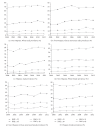Prevalence and Trends of Adult Obesity in the US, 1999-2012
- PMID: 25002986
- PMCID: PMC3913362
- DOI: 10.1155/2014/185132
Prevalence and Trends of Adult Obesity in the US, 1999-2012
Abstract
Aim. To provide national estimates of obesity among US adults aged 20 years and older in 2011-2012 and track its trends from 1999 to 2012. Methods. Measured weight/height from National Health and Nutrition Examination Survey 1999-2012 waves was used to calculate body mass index (BMI) and prevalence measures. Piecewise logistic regressions were conducted to test the differential trends before and after 2010. Results. In 2011-2012, the age-adjusted prevalence of overweight and obesity combined (BMI ≥ 25) was 71.1% (95% CI: 68.0%-74.2%) among men and 65.5% (61.8%-69.3%) among women, and the prevalence of obesity (BMI ≥ 30) was 33.3% (30.5%-36.2%) among men and 35.8% (32.3%-39.4%) among women. From 1990-2000 to 2009-2010, the prevalence of overweight and obesity combined, obesity, grades 2 and 3 obesity combined (BMI ≥ 35), and grade 3 obesity (BMI ≥ 40) increased by 7.2%, 17.8%, 17.6%, and 33.0%, respectively. Compared to 2009-2010, most gender- and race/ethnicity-specific prevalence measures remained unchanged or slightly decreased in 2011-2012. No significant difference in trends among prevalence measures was found before and after 2010. Conclusions. Concurrent evidence on the leveling off of obesity in the US is thin. Given its high prevalence and profound socioeconomic consequences, close monitoring of the trend is warranted.
Figures


Similar articles
-
Prevalence of overweight and obesity in the United States, 1999-2004.JAMA. 2006 Apr 5;295(13):1549-55. doi: 10.1001/jama.295.13.1549. JAMA. 2006. PMID: 16595758
-
Trends in Adiposity and Food Insecurity Among US Adults.JAMA Netw Open. 2020 Aug 3;3(8):e2012767. doi: 10.1001/jamanetworkopen.2020.12767. JAMA Netw Open. 2020. PMID: 32766803 Free PMC article.
-
Prevalence of obesity and trends in the distribution of body mass index among US adults, 1999-2010.JAMA. 2012 Feb 1;307(5):491-7. doi: 10.1001/jama.2012.39. Epub 2012 Jan 17. JAMA. 2012. PMID: 22253363
-
Prevalence and trends in obesity among US adults, 1999-2008.JAMA. 2010 Jan 20;303(3):235-41. doi: 10.1001/jama.2009.2014. Epub 2010 Jan 13. JAMA. 2010. PMID: 20071471
-
Differences in Obesity Prevalence by Demographic Characteristics and Urbanization Level Among Adults in the United States, 2013-2016.JAMA. 2018 Jun 19;319(23):2419-2429. doi: 10.1001/jama.2018.7270. JAMA. 2018. PMID: 29922829 Free PMC article.
Cited by
-
Epidemiology of Obesity and Diabetes and Their Cardiovascular Complications.Circ Res. 2016 May 27;118(11):1723-35. doi: 10.1161/CIRCRESAHA.115.306825. Circ Res. 2016. PMID: 27230638 Free PMC article. Review.
-
Cigarette Smoking and Prostate Cancer Mortality in Four US States, 1999-2010.Prev Chronic Dis. 2016 Apr 14;13:E51. doi: 10.5888/pcd13.150454. Prev Chronic Dis. 2016. PMID: 27079649 Free PMC article.
-
Change in daily energy intake associated with pairwise compositional change in carbohydrate, fat and protein intake among US adults, 1999-2010.Public Health Nutr. 2015 Jun;18(8):1343-52. doi: 10.1017/S1368980014001876. Epub 2014 Sep 10. Public Health Nutr. 2015. PMID: 25203716 Free PMC article.
-
Cardiometabolic Health in Submariners Returning from a 3-Month Patrol.Nutrients. 2016 Feb 9;8(2):85. doi: 10.3390/nu8020085. Nutrients. 2016. PMID: 26867201 Free PMC article.
-
A CBPR Study to Test the Impact of a Church-Based Health Empowerment Program on Health Behaviors and Health Outcomes of Black Adult Churchgoers.J Racial Ethn Health Disparities. 2017 Feb;4(1):70-78. doi: 10.1007/s40615-015-0203-y. Epub 2016 Jan 29. J Racial Ethn Health Disparities. 2017. PMID: 26830631 Clinical Trial.
References
-
- NIH, NHLBI Obesity Education Initiative. Clinical Guidelines on the Identification, Evaluation, and Treatment of Overweight and Obesity in Adults, the Evidence Report. October 2013, http://www.nhlbi.nih.gov/guidelines/obesity/ob_gdlns.pdf. - PubMed
-
- Fryar CD, Carroll MD, Ogden CL. Prevalence of overweight, obesity, and extreme obesity among adults: United States, trends 1960–1962 through 2009-2010. October 2013, http://www.cdc.gov/nchs/products/hestats.htm.
-
- OECD. OECD Obesity Update 2012. October 2013, http://www.oecd.org/health/health-systems/theeconomicsofprevention.htm.
-
- Finkelstein EA, Trogdon JG, Cohen JW, Dietz W. Annual medical spending attributable to obesity: payer-and service-specific estimates. Health Affairs. 2009;28(5):w822–w831. - PubMed
LinkOut - more resources
Full Text Sources
Other Literature Sources
